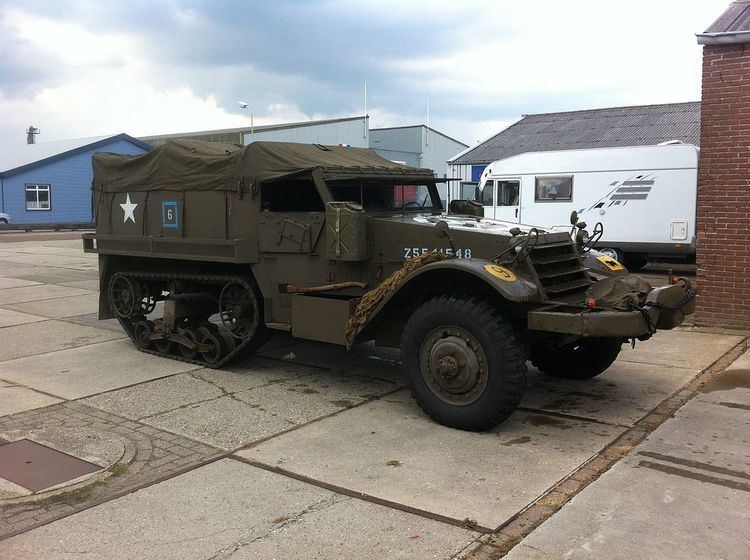Place of origin United States Used by See list of operators | In service 1943–67 Designer Ordnance Department | |
 | ||
Type Half-track armored personnel carrier Wars World War II, 1948 Arab-Israeli war, Suez Crisis, Six-Day War | ||
The M5 Half-track (officially the Carrier, Personnel Half-track M5) was an American armored personnel carrier in use during World War II. It was developed in 1942 when existing manufacturers of the M2 Half Track Car, and M3 Half-track could not keep up with production demand. International Harvester (IH) had capacity to produce a similar vehicle to the M3, but some differences from it had to be accepted due to different production equipment. The M5 was produced by IH from December 1942 to October 1943.
Contents
Using the same chassis as their M5, IH could produced an equivalent to the M2, which was the M9 Half-track. There are also variants of the M13 and M16 MGMCs based on the M5. The M13 and M16 were exported to the United Kingdom and to Soviet Union respectively. The M5 was supplied to Allied nations (the British Commonwealth, France, and the Soviet Union) under the Lend-Lease. After the war, it was leased to many countries in the NATO. It served with Israel in multiple different wars and was developed by the country into the M3 Mark A and the M3 Mark B.
Specifications
The specifications of the M5 were almost identical to the specifications of the M3 Half-track. It was 20.8 feet (6.3 m) long, 7.3 feet (2.23 m) wide, 9 feet (2.74 m) high, and weighed 21,500 pounds (9.8 t). It had vertical volute springs for the tracks and semi-elliptical longitudal leaf springs for the wheels. It was powered by a 142 hp (106 kW) White 160AX, 386 cubic inch (6,330 cc), 6-cylinder engine, with a compression ratio of 6.35:1. It had a fuel capacity of 60 US gallons (230 l), a range of 125 miles (201 km), and a speed of 42 miles per hour (68 km/h). It had constant mesh transmission, 6.5–13.5 mm (0.26–0.53 in) of armor, one 0.5 in (12.7 mm) M2 machine gun and two 0.3 in (7.6 mm) M1919 machine guns, and crew of three with up to ten passengers.
Development
After the attack on Pearl Harbor, the demand for U.S. produced armored vehicles grew and the existing production capacity was stretched by the need to equip the expanding U.S. military as well as its allies. As a result, the war munitions industry in the U.S. rapidly expanded. While the existing manufacturers of M3 half-tracks could not meet the increased demands, International Harvester (IH) could build them, but changes in components and construction were necessary. Prototype vehicles were provided designated as the M3E2 and the M2E5. After testing by General Motors, they were accepted for production under the designations M5 and M9 respectively.
Due to a lack of face-hardened armor, homogeneous armor was used instead. Although thicker at 5⁄16 inch (7.9 mm) to the M3's 1⁄4 inch (6.4 mm), it was effectively less protection – armor-piercing rifle-caliber bullets could penetrate it at 300 yards (270 m) rather than 200 yards (180 m) for the M3. At the same time, IH was to produce a version of the M2 Half Track Car, the M9 Half-track.
Service history
The first production run of the M5 was completed in December 1942. Changes to the demand for half-tracks led to reduced orders within the U.S. Army, and the M5 became "limited standard" for the U.S. A total of 7,484 were produced before production was stopped in October 1943. Almost all M5s were sent to U.S. allies for further use. The added weight of the armor reduced the speed to 42 mph, and range was reduced to 125 mi. The final vehicles were completed in October 1943.
In the UK, it was used as an artillery tractor for towing the British 6-pounder and 17-pounder guns, due to the Universal Carrier already fulfilling the infantry transport role. Some were also retained in the U.S. for training purposes.
The M5 later saw service with the Israeli army in the 1948 Arab-Israeli war. They were commonly painted red to disguise them as agricultural tractors. In 1955, the Israelis used M5s to make the M3 Mark A and the M3 Mark B. The former was an M3 or M5 with a few modifications and the latter was a M5 converted into a command carrier. Regular M5s were simply designated "M3 IHC". It was later used in the Suez Crisis and the Six-Day war. By the Yom Kippur War, the M3/M5 had been replaced by the M113 armored personnel carrier.
Operators
During the war, the majority of M5 (and M9) production went to the United Kingdom, which then passed them on to Commonwealth forces or other allies operating with the British Army, such as Free Polish or Free Czech forces. The Soviet Union received supplies directly. In British service, they were used as utility vehicles for Royal Engineers units, or to tow anti-tank guns in motor battalions instead of 15cwt trucks.
After the war, half tracks were provided under the Military Aid Program (MAP).
